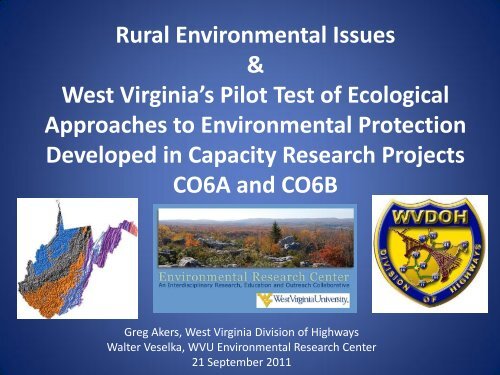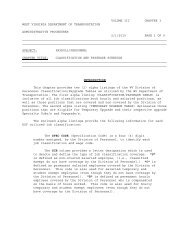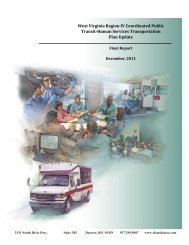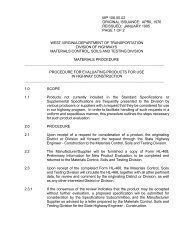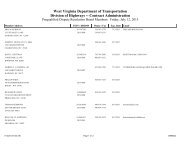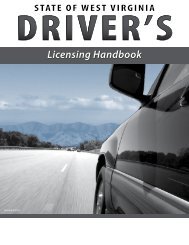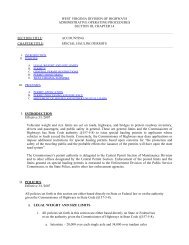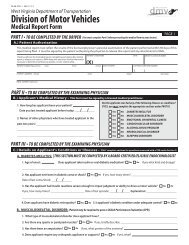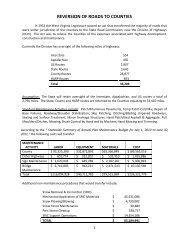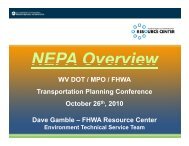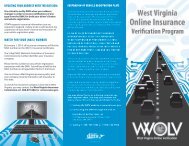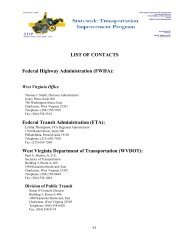Rural Environmental Issues - West Virginia Department of ...
Rural Environmental Issues - West Virginia Department of ...
Rural Environmental Issues - West Virginia Department of ...
Create successful ePaper yourself
Turn your PDF publications into a flip-book with our unique Google optimized e-Paper software.
<strong>Rural</strong> <strong>Environmental</strong> <strong>Issues</strong>&<strong>West</strong> <strong>Virginia</strong>’s Pilot Test <strong>of</strong> EcologicalApproaches to <strong>Environmental</strong> ProtectionDeveloped in Capacity Research ProjectsCO6A and CO6BGreg Akers, <strong>West</strong> <strong>Virginia</strong> Division <strong>of</strong> HighwaysWalter Veselka, WVU <strong>Environmental</strong> Research Center21 September 2011
The Planning Challenges6 th largest road networkmaintained by one managemententity in United States– #1 in maintaining bridgesPlanning for climate, topography& future economic opportunitiesFiscally responsible to public
The public…The <strong>Rural</strong> Challenges...is hard to please
Regulatory Challenges
The Transformational ChallengePerceptionTools &MOUsActionOutreach &Workshops
The route to changeAdaptivemanagement:Outreach &constantfeedbackHistoric back and forth with US EPA, DEP,DNR, Washington DC, etc.The grind: adoption and learningnew tools, trying new things
The Mandate for a Fresh StartBasic framework for using an ecosystem approach intransportation planning across individual agency jurisdictionsand encourages an outcome-based approach to conservationPuts the cards on the table forBLM , NOAA, NPSEPA - Greater flexibility to do environmental goodFHWA - Streamlined project development and improved mitigation opportunitiesUSACE - Finding the balance to keep waters clean and clearUSFS - Stewardship <strong>of</strong> natural resources and facilitated use <strong>of</strong> public landsUSFWS - One conservation framework, endless possibilities for partnership
Change From WithinChange beings with the Planners and Transfersthrough the OrganizationMore readily accepted if all changes can begrounded in accountability to the public goodand fiscal responsibility.Let’s have a look at some challenges
Planning Challenges-PerceptionsRoads - How hard can it be?
Planning Challenges-RealitiesDistinct planning regionsMany ‘over-seers’Lack <strong>of</strong> consistent Sources for GIS data Accountability from ‘planned’ to ‘field’Limited time for numerous road maintenanceprojects
Planning Challenges-Actions & SolutionsWV State GIS Data Clearinghousehttp://wvgis.wvu.edu/
Planning Challenges-Actions & SolutionsAccentuate the Outcomes <strong>of</strong> Highway ResearchSHRP 2 Project for Coalfields Expressway and King Coal Highway• Showcase use <strong>of</strong> publicly available data GIS State Clearinghouse updates as per WVDOH needs• Incorporate Applied Research in Planning WVSCI scores predictors Mitigation site location tool Harnessing environmental stakeholders and ‘powerbrokers’• TNC, DNR, EPA
<strong>Rural</strong> Challenges-Public PerceptionsWhy can’t they fix my potholes?Why hasn’t my road edge been brush-hogged?When is my road going to get plowed?
<strong>Rural</strong> Challenges-The RealitiesPick your saying..Nightmare, juggling flaming knives, herdingcats
<strong>Rural</strong> Challenges-Actions and SolutionsDemonstrate / seek out efficiencies that will shiftresources to satisfy publicProvide an automated forum for suggestions andways to save money (website link)• Showcase any changes• Mow less highways ROW improved wildlife/pollinator habitat, saves money and time forother road maintenance activities
Regulatory Challenges-PerceptionWVDOH is too cumbersome and resistant to change• Not incorporating new environmental designsWVDOH is not accountable in applying MOUs
Regulatory Challenges-RealitiesWVDOH catching up to a moving targetTakes time to implement institutional changes– Must make all aware <strong>of</strong> expectations Includes subcontractors Boots on the ground employeesImprove upon culture <strong>of</strong> continual improvementand emphasize record-keeping for accountability• Improved plow design as per Donny Williams, etc.
Changing Perception <strong>of</strong> RegulatorsFHWA- Keeping it SimpleLots <strong>of</strong> suggestions from other states for Simpleand Cheap, <strong>Environmental</strong> FixesLooking for Mussels in all the Right PlacesNew Roadside get less Clearing, moreWildlife Habitat
Understanding Nationwide Permits• Aquatic Life Movements- No activity may substantially disrupt thenecessary life cycle movements <strong>of</strong> those species <strong>of</strong> aquatic lifeindigenous to the waterbody, including those species that normallymigrate through the area, unless the activity's primary purpose is toimpound water. Culverts placed in streams must be installed tomaintain low flow conditions• Management <strong>of</strong> Water Flows- To the maximum extent possible, thepre-construction course, condition, capacity and location <strong>of</strong> openwater must be maintain for each activity, including streamchannelization and storm water management activities, except asprovided below. The activity must not restrict or impede thepassage <strong>of</strong> normal or high flows, unless the primary purpose <strong>of</strong> theactivity is to impound water or manage high flows. The activitymay alter pre-construction course, condition, capacity, andlocation <strong>of</strong> open waters if it benefits the aquatic environment (e.g.stream restoration or relocation activities.
NWP 14- Linear Transportation ProjectsFor intermittent streams and greater….• Culverts must completely span bankful channel• The inlet/ outlets must be designed in such a manner as to maintain thesubstrate in the bottom <strong>of</strong> the culverts. Countersinking the culvert to thesub-pavement <strong>of</strong> the streambed or the use <strong>of</strong> a bottomless culvert willgenerally fulfill this requirement• …permit must be obtained for proposed culverted stream crossings that donot pass aquatic life and / or do not freely pass bankful flows.– Such crossings may require compensatory mitigation.– Mitigation is $$$
Culvert Replacement Checklisthttp://www.fws.gov/midwest/Fisheries/streamcrossings/ReplacementStructures.htmRound culvertsfor 0-3% grade
Regulatory Challenges-Actions & SolutionsBridging the Accountability Gap throughRecord Keeping/ Training• Uniform system <strong>of</strong> Education / Certification in regards to each district <strong>Environmental</strong> compliance training for routine maintenance e.g. culverts, ditches, gutters, salt applications, etc.• Contractor environmental training required Condition <strong>of</strong> the job, applies to contractors and anyone onsite• Not re-inventing the wheel – using applicable tools AASHTO- <strong>Environmental</strong> Stewardship Practices, Procedures, and Policiesfor Highway Construction and Maintenance
SHRP 2 - Putting it all TogetherStreamlining- Effective and Efficient1. Integration <strong>of</strong> planning and project development processes2. Use <strong>of</strong> context-sensitive designs and solutions3. Development <strong>of</strong> programmatic agreements4. Use <strong>of</strong> flexible mitigation5. Expenditures on technology, training, and staff6. Employment <strong>of</strong> alternative dispute resolutionBackcasting look at Coalfields Expressway and King Coal Highways
The ‘hidden’ objectives?Facilitate discussions and communicationsProduce an <strong>of</strong>f-the-shelf applied academic product• based on the previous toolsEnable consistency by both regulatory agencies andDoH (and other entities) in regards toEXPECTATIONS and CLEAR PROCEDURES that isTRANSFERABLE– i.e. transmission lines, Marcellus pipelines, etc.
Current shortcomingsPostage stamp mitigationMitigation banking market not matured in WV– Earthmark / Meadow River is not cure-allT and E consultations tools not up to dateLack <strong>of</strong> consistency for wholesale top to bottomadoption <strong>of</strong> ‘green’ practices
Project OverviewKeep overall goal simpleUse restoration to maximize “number <strong>of</strong> miles <strong>of</strong> swimmableand fishable waters”Step 1: Calculate maximum mitigation‘bill’ in terms <strong>of</strong> the ecological units foreach route (avoidance)– Wetlands– Streams– T & E speciesNEPA meant to consider cumulative effects<strong>of</strong> both direct and indirect impacts- thiswatershed approach incorporates this.
Step 2: Based on mitigation liability …Identify where DoT investments could make thegreatest difference for watershed, species, orecoregional health and sustainabilityFixing ‘crappy houses’ in good neighborhoods
Step 3 – Reward for above andbeyondImplement mitigation according to bill with localpartner for long-term maintenance andmonitoring, HOWEVER…Maintain accountability during as-build• E & S and corresponding water quality monitoring• ‘Green’ design- countersunk culverts, natural stream channel designMinimization <strong>of</strong> impacts via BMPs leads to ‘rebate’ <strong>of</strong>credits able to re-use or re-sell.
Streamlining keys- revisited1. Integration <strong>of</strong> planning and projectdevelopment processesMitigation liability quantified ahead <strong>of</strong> timeTools allow avoidance <strong>of</strong> resources
Streamlining keys- revisited2. Use <strong>of</strong> context-sensitive designsand solutionsSunk culverts for wildlife crossings and aquaticlifeNatural Stream Channel Design over Riprap
Streamlining keys- revisited3. Development <strong>of</strong> programmaticagreementsEncourage mechanisms that give assurancesbetween agencies• <strong>Environmental</strong> checklists for projects• Contractors required to have environmentalsensitivity training
Streamlining keys- revisited4. Use <strong>of</strong> flexible mitigationEcological Unit concept to maximize fishable andswimmable• Include chemical treatment options• Multiple stewards <strong>of</strong> land (TNC, Canoe trails,Hatfield McCoy)
Streamlining keys- revisited5. Expenditures on technology,training, and staff‘Green Sheets’ implementing practices for accountabilityUniform training between districts top to bottomRequired contractor training
Streamlining keys- revisited6. Employment <strong>of</strong> alternative disputeresolutionNeed WVDOH to help push resource agencies towardsusing this tool as opportunity for mediation
Points to take home….Need to want to change, shape solution instead <strong>of</strong>being forced….remember goalMaximizing fishable and swimmable stream miles =Net benefit economically andenvironmentally
Lunchtime DiscussionsWhat are some other barriers that you see toincorporating environmental planning? Howdo we overcome them?What mechanisms could be implemented inhouseby WVDOH that could alleviateregulatory concerns
Thanks for your time and feel free to contact mewith any questions or concerns…Walter.Veselka@mail.wvu.edu(304) 293-3789


